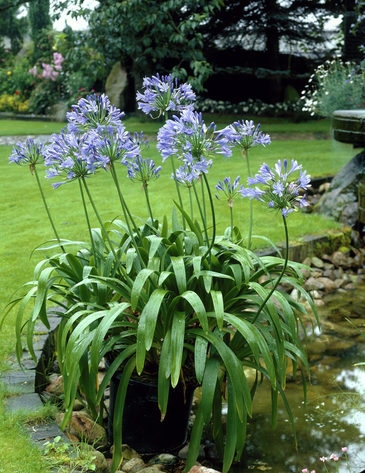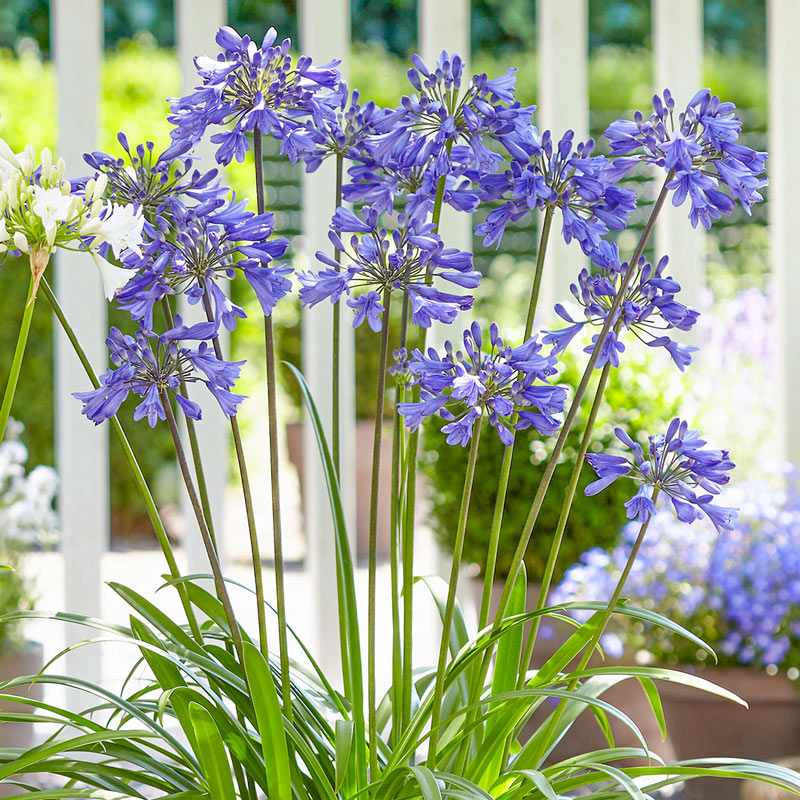Spectacular Agapanthus: Enhancing Your Yard's Elegance
Wiki Article
Unleashing the Secret to Effective Agapanthus Farming: Advice for a Flourishing Yard
In the world of gardening, cultivating agapanthus efficiently calls for a critical method that encompasses numerous facets of plant care. By recognizing the nuances of agapanthus farming, one can create an atmosphere where these plants grow and bloom perfectly.Growing Agapanthus: Best Practices
When planting Agapanthus, appropriate soil preparation is essential for making sure effective development and advancement of these beautiful flowers. Agapanthus, frequently called Lily of the Nile or African lily, grows in well-draining dirt with a slightly acidic to neutral pH level - Agapanthus. Before planting, it is vital to change hefty clay soils with raw material such as garden compost or peat moss to improve drain and provide vital nutrients for the plantsTo grow Agapanthus, choose a location that obtains complete sunshine to partial shade, as this will advertise healthy and balanced growth and bountiful blooming. Dig an opening twice the diameter of the plant's origin sphere and position the Agapanthus at the same depth it was previously growing. Carefully backfill the hole with dirt, pushing down strongly to remove any type of air pockets around the origins.
Water the newly grown Agapanthus extensively and remain to keep the dirt equally moist, especially throughout the plant's energetic expanding season. Agapanthus. Using a well balanced plant food once a month can better support the plant's growth and blooming. By adhering to these ideal techniques for planting Agapanthus, you can develop a magnificent display of these fascinating flowers in your yard
Suitable Soil Conditions for Agapanthus
For ideal development and blooming success of Agapanthus plants, ensuring the dirt conditions are ideal is vital. Agapanthus flourishes in well-draining dirt with a slightly acidic to neutral pH degree ranging from 6.0 to 7.0. This kind of soil enables adequate water drain, protecting against waterlogging which can cause root rot. To improve dirt drain, think about including raw material such as garden compost or peat moss when preparing the growing website. Additionally, Agapanthus likes soil that is rich in nutrients, so integrating a well balanced fertilizer during the expanding period can promote healthy and balanced development and vivid flowers.
Watering and Feeding Tips
To ensure healthy growth and dynamic flowers, correct watering and feeding techniques are vital for successful Agapanthus farming. Agapanthus plants profit from routine watering, especially during view website the growing season.When it concerns fertilizing Agapanthus, a well balanced plant food with equal parts nitrogen, phosphorus, and potassium can be used in the springtime to promote healthy growth and flowering. Slow-release fertilizers are excellent for providing nutrients gradually over an extensive period. Avoid over-fertilizing, as this can bring about too much foliage development at the cost of blossoms.
Furthermore, incorporating natural issue like compost right into the soil can improve nutrient levels and boost soil structure, aiding in the total wellness of the Agapanthus plants. By following these watering and fertilizing tips, garden enthusiasts can ensure their Agapanthus plants grow and create sensational displays of blossoms.
Trimming and Deadheading Techniques
Correct pruning and deadheading methods play an essential duty in keeping the health and wellness and aesthetic appeals of Agapanthus plants, enhancing the vital techniques of watering and fertilizing for effective farming. Trimming Agapanthus entails getting rid of spent blossom heads, yellowing or dead leaves, and total shaping of the plant to promote better growth. Deadheading, the process of getting rid of why not check here faded blossoms, not only enhances the plant's look yet additionally urges further flowering.When deadheading Agapanthus, Get the facts it is recommended to clip off the blossom stem at the base making use of sharp, tidy shears. This process reroutes the plant's power from seed manufacturing back into origin and vegetation development, promoting a much healthier and much more robust plant. Routine deadheading can prolong the blooming period of Agapanthus and avoid self-seeding, which can cause congestion.
In terms of pruning, Agapanthus usually take advantage of a light trim after blooming to clean the plant and urge fresh development. Cutting down the invested flower stems and getting rid of any kind of dead or broken vegetation assists maintain the plant's vitality and general appearance. Nevertheless, it is vital to stay clear of reducing into the crown of the plant, as this can damage its wellness.

Protecting Agapanthus From Vermins and Diseases
Implementing reliable parasite and disease monitoring techniques is crucial to securing the wellness and vitality of Agapanthus plants in growing. One typical pest that impacts Agapanthus is the Agapanthus borer, a caterpillar that passages into the plant, creating damage to the leaves and blossoms.In addition to bugs, Agapanthus are susceptible to diseases such as root rot and fungal leaf places. By remaining vigilant and addressing pest and disease issues quickly, gardeners can help their Agapanthus flourish and thrive.

Verdict
In verdict, successful growing of agapanthus requires correct planting strategies, optimal dirt conditions, appropriate watering and feeding, regular pruning and deadheading, and security from diseases and insects. By adhering to these pointers and tricks, garden enthusiasts can ensure a prospering yard full of lovely agapanthus flowers. Agapanthus. Remember to preserve regular care and attention to information to promote the health and wellness and longevity of these sensational plantsWhen planting Agapanthus, appropriate dirt prep work is important for making sure successful growth and development of these attractive flowers.Water the newly planted Agapanthus extensively and proceed to maintain the dirt evenly moist, especially throughout the plant's energetic growing season.For ideal development and blooming success of Agapanthus plants, guaranteeing the dirt problems are excellent is critical. When transplanting or planting Agapanthus, guarantee the dirt is well-prepared to provide the necessary foundation for the plants to develop themselves efficiently. One typical bug that influences Agapanthus is the Agapanthus borer, a caterpillar that passages right into the plant, triggering damages to the leaves and flowers.
Report this wiki page